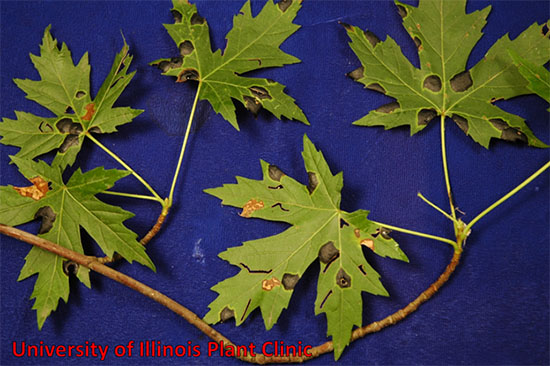Issue 15, August 31, 2015
Fix My Tree!

There are a large number of "cosmetic" plant diseases, usually found on the leaves. On woody plants these include some anthracnose blights, powdery mildew, tar spot of maples, and tubakia leaf spot of oaks. Chemical treatment for these diseases is rarely warranted. This is largely due to two considerations: efficacy and need.
When deciding on recommending management plans, we consider the principles of Integrated Pest Management (IPM): pest identification; monitoring and assessing pest numbers and damage; guidelines for when management action is needed; preventing pest problems; using a combination of biological, cultural, physical/mechanical, and chemical management tools. The purpose of IPM is to use an understanding of the biology of the pest, along with available pest control methods, to "manage pest damage by the most economical means, and with the least possible hazard to people, property, and the environment" (quote from the Environmental Protection Agency). Simply put, the idea behind IPM is to decide if a pest needs management and, if so, how to do so in an effective, safe, and economical manner.
Let's consider the pictured maple tree. The owner of the tree may be understandably worried when they first notice large black spots on the leaves. Their first thought is "How do I fix this?" but the better question would be "Is this really a problem?" To determine if it's a problem, we first have to identify the problem. In this case, it's tar spot, a common fungal disease that does not threaten the overall health of an otherwise healthy tree. This answers part of that first question: "Is this really a problem?" The answer is no, at least not from a plant health standpoint. If that's all we care about, our management decision is easy: no control is needed.
However, if the aesthetics of the tree are still an issue, we may want to consider management. Recommendations for tar spot include a number of contact fungicides and destroying fallen infected leaves. Let's start with the least invasive first: sanitize, or rake and remove the fallen infected leaves. This will help reduce infection the next season. Destroying the fallen leaves will not "fix" the infected leaves still on the tree. Still want to spray a fungicide? Unfortunately, fungicides won't fix the current leaves either. The fungicides labeled for use against tar spot in maple are protectants which protect newly-emerging leaves from infection. The fungicides will not be able to "cure" the already infected leaves.
Another important consideration when making a decision involving pesticides is what level of control can I expect? A general rule of thumb for most contact pesticides is around 80%. Now consider the size of the tree canopy, and the fact that the fungicide needs to be applied to both sides of the leaf surfaces. The cost for the fungicide and application should also be factored into the decision. In most cases, treating a mature tree for a cosmetic issue simply isn't environmentally sound, effective, or economical.
Finally, we should consider contributing factors. If the tree is a newly-transplanted seedling and we're concerned about it establishing well, or if it's a bonsai enduring the stress of being pruned and shaped, that may alter some of our decisions. In both of those cases, a protective fungicide applied at the right time may be worth considering to reduce stress on the tree, and because the tree should still be small enough that the application is feasible.
Regardless of the situation, multiple management strategies should be considered, and multiple strategies can be used. In the above scenario, I would recommend removing the infected fallen leaves regardless of whether a fungicide is used; in this way we reduce the amount of spore-producing inoculum near the susceptible host.
Considering the principles of IPM when making management decisions helps us manage the pests that need to be managed while reducing the pesticide load in the environment, and taking into account the amount of control expected and the cost associated. We frequently see cosmetic diseases at the Plant Clinic. Along with pest identification, we prepare management recommendations for each sample and explain the factors to take into account when deciding on a management plan. We advocate using the principles of integrated pest management to help guide management decisions. (Diane Plewa)
Author:
Diane Plewa